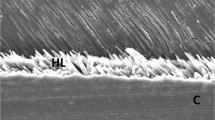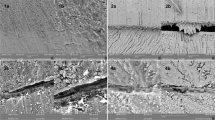Abstract
This study evaluated the effects of different parameters of dentin irradiation with erbium-doped yttrium aluminum garnet (Er:YAG) laser on bond strength to dentin and analyzed the ultramorphological characteristics of resin–laser-irradiated dentin interfaces using a transmission electron microscope (TEM). Dentin surfaces were abraded with SiC paper (600 grit) or Er:YAG laser-irradiated (120/4, 140/6, 180/4, or 200/6 mJ/Hz). Three adhesive systems were tested: Single Bond Plus (3M ESPE), Clearfil Protect Bond (Kuraray Med.), and Clearfil Tri-S Bond (Kuraray Med.). Treatments were performed over flat dentin surfaces of human third molars. Specimens were stored in distilled water for 1 week or 6 months and prepared for a microtensile bond strength test and interfacial ultrastructure for analysis. Microtensile bond strength data (n = 5) were analyzed with three-way analysis of variance. Irradiation with Er:YAG laser did not reduce the bond strength values for self-etching adhesives even after 6 months of water storage. The hybrid layer formation was observed only when the adhesives were applied to non-irradiated dentin (control group). Nanoleakage occurred in all resin–dentin interfaces using Single Bond Plus for both periods. Nanoleakage pattern and bond strength of self-etching adhesives to dentin were less affected by Er:YAG laser irradiation and by the 6-month storage in water than was those of the etch-and-rinse adhesive. TEM analysis revealed no hybridization when dentin was laser-irradiated. Clinical significance: Minimally invasive caries removal has been proposed. Nevertheless, bonding mechanisms to lased dentin are not entirely described. Knowing the interaction between the treated dentin and bonding agents and its behavior over time is of utmost importance for new technologies. Regarding that, two-bottle self-etching adhesive system provided a more consistent evidence of its better behavior when bonding to lased substrate.









Similar content being viewed by others
References
Apel C, Meister J, Gotz H, Duschner H, Gutknecht N (2005) Structural changes in human dental enamel after subablative erbium laser irradiation and its potential use for caries prevention. Caries Res 39:65–70
Aranha ACC, Eduardo CP, Gutknecht N, Marques MM, Ramalho KM, Apel C (2007) Analysis of the interfacial micromorphology of adhesive systems in cavities prepared with Er, Cr:YSGG, Er:YAG laser and bur. Microsc Res Tech 70:745–751
Esteves-Oliveira M, Zezell DM, Apel C, Turbino ML, Aranha MCC, Eduardo CP, Gutknecht N (2007) Bond strength of self-etching primer to bur cut, Er, Cr:YSGG, and Er:YAG lased dental surfaces. Photomed Laser Surg 25:373–380
He Z, Otsuki M, Sadr A, Tagami J (2009) Acid resistance of dentin after erbium: yttrium-aluminum-garnet laser irradiation. Lasers Med Sci 24:507–513
Carvalho AO, Reis AF, de Oliveira MT, de Freitas PC, Aranha AC, Eduardo CP, Giannini M (2011) Bond strength of adhesive systems to Er, Cr:YSGG laser-irradiated dentin. Photomed Laser Surg 29:747–752
Hibst R, Keller U (1989) Experimental studies of the application of the ER:YAG laser on the dental hard substances: I measurement of the ablation rate. Lasers Surg Med 9:338–344
Keller U, Hibst R (1989) Experimental studies of the application of the Er:YAG laser on the dental hard substances: II light microscopic and SEM investigations. Lasers Surg Med 9:345–351
Visuri SR, Gilbert JL, Wright DD, Wigdor HA, Walsh JT Jr (1996) Shear strength of composite bonded to Er:YAG laser-prepared dentin. J Dent Res 75:599–605
Curti M, Rocca JP, Bertrand MF, Nammour S (2004) Morphostructural aspects of Er:YAG prepared class V cavities. J Clin Laser Med Surg 22:119–124
Oliveira MT, Freitas PM, Paula Eduardo C, Ambrosano GM, Giannini M (2007) Influence of diamond sono-abrasion, air-abrasion and Er:YAG laser irradiation on bonding of different adhesive systems to dentin. Eur J Dent 1:158–166
Ceballos L, Toledano M, Osorio R, Tay FR, Marshall GW (2002) Bonding to Er-YAG-laser-treated dentin. J Dent Res 81:119–122
Oliveira MT, Arrais CA, Aranha AC, Paula Eduardo C, Miyake K, Rueggeberg FA, Giannini M (2010) Micromorphology of resin-dentin interfaces using one-bottle etch&rinse and self-etching adhesive systems on laser-treated dentin surfaces: a confocal laser scanning microscope analysis. Lasers in Surgery Medicine 42:662–670
Moretto SG, Azambuja N Jr, Arana-Chavez VE, Reis AF, Giannini M, Eduardo CP, De Freitas PM (2011) Effects of ultramorphological changes on adhesion to lased dentin—scanning electron microscopy and transmission electron microscopy analysis. Microsc Res Tech 74:720–726
Aoki A, Ishikawa I, Yamada T, Otsuki M, Watanabe H, Tagami J, Ando Y, Yamamoto H (1998) Comparison between Er:YAG laser and conventional technique for root carious treatment in vitro. J Dent Res 77:1404–1414
Munck DJ, Meerbeek VB, Yudhira R, Lambrechts P, Vanherle G (2002) Micro-tensile bond strength of two adhesive to Er:YAG laser vs. bur-cut enamel and dentin. Eur J Oral Sci 110:322–329
Reis AF, Bebran-Russo AK, Giannini M, Pereira PNR (2007) Interfacial ultramorphology of single-step adhesives: nanoleakage as a function of time. J Oral Rehabil 34:213–221
Reis AF, Giannini M, Pereira PNR (2007) Long-term TEM analysis of the nanoleakage patterns in resin–dentin interfaces produced by different bonding strategies. Dent Mater 23:1164–1172
Reis AF, Carrilho MRO, Ghaname E, Pereira PNR, Pereira M, Nikaido T, Tagami J (2010) Effects of water-storage on the physical and ultramorphological features of adhesives and primer/adhesive mixtures. Dent Mater J 29:697–705
Fowler BO, Kuroda S (1986) Changes in heated and in laser irradiated human tooth enamel and their probable effects on solubility. Calcif Tissue Int 8:197–208
Meurman JH, Voegel JC, Rauhamma-mäkinem R, Gasser P, Thomann JM, Hemmerle J, Luomanen M, Paunio L, Frank RM (1991) Effects of carbon dioxide, Nd:YAG and carbon dioxide Nd:YAG combination lasers at high energy densities on synthetic hydroxyapatite. Caries Res 26:77–83
Fan D, Legeros RZ (1995) Consequence of heat treatment on properties of dentin. J Dent Res 74:525
Yoshida Y, Nagakane K, Fukuda R, Nakayama Y, Okazaki M, Shintani H (2004) Comparative study on adhesive performance of functional monomers. J Dent Res 83:454–458
Fu B, Sun X, Qian W, Shen Y, Chen R, Hannig M (2005) Evidence of chemical bonding to hydroxyapatite by phosphoric acid esters. Biomaterials 26:5104–5110
Fukegawa D, Hayakawa S, Yoshida Y, Suzuki K, Osaka A, Van Meerbeek B (2006) Chemical interaction of phosphoric acid ester with hydroxyapatite. J Dent Res 85:941–944
Van Landuyt KL, Snauwaert J, De Munck J, Peumans M, Yoshida Y, Poitevin A, Coutinho E, Suzuki K, Lambrechts P, Van Meerbeek B (2007) Systematic review of the chemical composition of contemporary dental adhesives. Biomaterials 28:3757–3785
Brulat N, Rocca JP, Leforestier E, Fiorucci G, Nammour S, Bertrand MF (2008) Shear bond strength of self-etching adhesive systems to Er:YAG-laser-prepared dentin. Lasers Med Sci 24:53–57
De Munck J, Van Landuyt K, Peumans M, Poitevin A, Lambrechts P, Braem M, Van Meerbeek B (2005) Critical review of the durability of adhesion to tooth tissue: methods and results. J Dent Res 84:118–132
Tay FR, Pashley DH, Yoshiyama M (2002) Two modes of nanoleakage expression in single-step adhesives. J Dent Res 81:472–476
Tay FR, King NM, Chan KM, Pashley DH (2002) How can nanoleakage occur in self-etching adhesive systems that demineralize and infiltrate simultaneously? J Adhes Dent 4:255–269
Author information
Authors and Affiliations
Corresponding author
Rights and permissions
About this article
Cite this article
de Oliveira, M.T., Reis, A.F., Arrais, C.A.G. et al. Analysis of the interfacial micromorphology and bond strength of adhesive systems to Er:YAG laser-irradiated dentin. Lasers Med Sci 28, 1069–1076 (2013). https://doi.org/10.1007/s10103-012-1157-5
Received:
Accepted:
Published:
Issue Date:
DOI: https://doi.org/10.1007/s10103-012-1157-5




